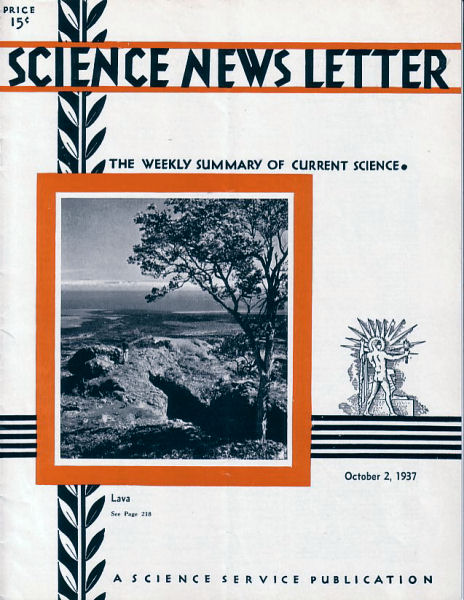From the October 2, 1937, issue

VOLCANIC ERUPTIONS PREDICTED
Where will the next great volcanic eruption occur, and when?
Will the older, semidormant volcanoes burst forth into new activity or will the well-known active volcanoes supply us with our next display of terrestrial pyrotechnics?
Will the new volcano which destroyed Rabaul, in New Guinea, recently, continue to erupt, or will it sink back into the sea and be heard of no more?
How can we tell?
Scientists have been studying the activities of nearly all the known volcanoes, and from these studies can sometimes predict with some accuracy the approximate time of an eruption.
Fragmentary accounts of the eruption at Rabaul, New Guinea, tell us graphically of the danger and terror accompanying the eruptions of Matupi and Vulcan volcanoes, in Rabaul harbor. On May 29 of this year, shortly after 4:00 P.M., Vulcan blew up. There were landslides and a mild earthquake, and in the words of witnesses, the sea seemed to draw away from the shore as if fearing the wrath of Pele, the volcano goddess.
Great crevasses opened on Matupi early that morning. Then came the black clouds and the explosion on Vulcan. Smoke and pumice, carrying along plumes of steam, blanketed everything.
The Matupi volcano also poured out molten earth. The night was terrible, with rain deluging everything.
BEES’ LANGUAGE DISCOVERED; IT’S STRANGE SORT OF DANCE
Bees have a language of scented dancing. By means of it a scout bee that has made a rich discovery can send his fellow workers out after honey with almost as much dispatch as police are rushed to points of need by radio calls.
Scientists used to think that bees located flowers by color or scent. This is partially true. But in an exhaustive study of the bee habits, Prof. K. Von Frisch of Munich found that bees communicate with one another by a strange sort of dance performed within the hive. In this way they tell where honey can be obtained most easily.
Often it will take hours and sometimes days for a good feeding place to be discovered. But when one bee has found the honey, many, perhaps several hundred, will appear in a very short time. And they all come from the same hive as the discoverer.
Prof. Von Frisch set out to discover the language or mode of communication of the bees.
Here’s what he found: If a new kind of flower begins to bloom, it is discovered by a scout bee. He loads up with honey and flies home. In the hive he reports the discovery by a queer sort of dance, turning round and round in a circle with queer tripping little steps, once to the right, once to the left, very vigorously, often for a minute on the same spot. Other bees crowd around with high interest. They rush out of the hive and soon can be found at the honey source.
The dance is a signal that honey has been found. The bee carries upon him the scent of the flower containing the nectar. The other bees noting this odor search for it as they fly out of the hive in all directions. Moreover, the discovering bee returns to the good honey source and broadcasts another odor created by a scent organ on its abdomen that also guides the other workers.
INFANTILE PARALYSIS WAVE HAS REACHED ITS PEAK
Eight hundred and seventy-nine new cases of infantile paralysis were reported to the United States Public Health Service during the week ending Saturday, Sept. 18. The total constituted a small increase over figures for the previous week, when 827 poliomyelitis sufferers were reported.
The peak of this year’s wave of the dread disease has probably been reached, the Public Health Service officials believe. Otherwise the health of the American nation is in good shape.
Illinois, where the number of new cases dropped from 130 to 81 during one week, relinquished first place in the list of states visited by infantile paralysis to New York, where 91 new cases were again reported. Minnesota with 52, Ohio with 59, Michigan with 57, Wisconsin with 45, Connecticut with 41, California with 46, and Pennsylvania with 40 cases were the states from which the most serious trouble was reported.
Behavior of the epidemic each fall during the last nine years led the Public Health Service to believe that this year’s outbreak has already reached its most menacing proportions and is due to recede. Infantile usually drops sharply with the approach of brisk weather. No predictions with regard to individual states, because of the lack of adequate past figures, were made.
Texas with 33 new cases against 21 the week before was one state to report a marked increase. Up to Sept. 18, 6,319 cases had been reported this year as compared with 2,261 during the same period last year. But the figures are still far below the proportions of the 1931 epidemic.







